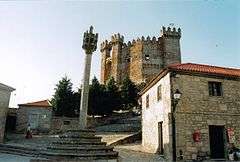Castle of Penedono
| Castle of Penedono | |
|---|---|
| Castelo de Penedono | |
 | |
| General information | |
| Location | Penedono, Portugal |
| Inaugurated | 12th century |
The Castle of Penedono (Portuguese: Castelo de Penedono), is a medieval castle located in the civil parish of Penedono e Granja, municipality of Penedono, in the Portuguese district of Viseu.
History
Early History
Archeological remains indicate the village was inhabited at least the Pre-Roman times.
Medieval Era
The oldest documented sources date from the Christian Reconquest of the area from the Moors. It mentions repopulating the area after the victory over the region by Ramiro Leon II at the battle of Simancas in 939 AD.[1]
The defense of the territory was entrusted to a man named Rodrigo Tedoniz. Rodrigo later would become the mayor of the town and lead the rebuilding of Penedono Castle.
During the eleventh century, it sat on the borders between the Christian kingdoms and the Muslim controlled-land. This led Penedono and its castle to change hands on several occasions. It finally landed in Christian hands upon conquest of the area by the Leonese King Fernando Magno in 1064. A survey in 1095 suggest a lot of things were left behind.
With the political independence of Portugal under Afonso I of Portugal, the lands were incorporated into the new nation. Subsequently, his successor King Sancho I (1185-1211), realizing the strategic position on the then-border, encouraged the re-population through the granting of a Foral Charter in 1195. His successor Alfonso II (1211-1223) confirmed its charter in 1217. The town and its castle also gained the attention of King Dinis (1270-1325), who led some reinforcements in its defense.
The current configuration of the castle dates back to the reign of Ferdinand (1367-1383).
The City Council at one point wanted to demolish the castle but the men of the village rose up and granted the castle is autonomy. The land surrounding the castle was later donated to D. Castco Fernandes Countinho, who rebuilt the castle.
In the context of the 1383-1385 Portuguese Interregnum, the mayor died in 1384 and was succeeded by his son Gonsalo Vasques Coutinho. The son later became a commander in the Orer of Avis. Besides the mayor and his son, other notable people born in the castler were Vasco Fernadnes Countinho, 1st Ear of Marialva, who was part of the ill-fated expedition to Tangier in 1437. Alvaro Goncalves Coutinho, known as the Gautn, He was a Portuguese warrior immortalized in the legend The Twelve of England
Under the reign of King Manuel I (1495-1521), the village received a New Foral in 1512, which attests to its importance at the time.[2]
Modern day
In the twentieth century, it was classified as a National Monument by decree published on June 23, 1910.
In 1940, as part of the celebrations of Centenarians, promoted by the Portuguese Estado Novo, the castle has undergone consolidation interventions and restoration of walls panels and towers by the charge of the General Directorate of National Buildings and Monuments. Further work took place in 1943 and in 1953, allowing the castle to be well maintained but still lacking works inside.
Characteristics
It sits on an irregular hexagonal site, with the side panels of stressed walls and protected by pyramidal battlements. Stone granite and schist define the northwest sector, reinforced by a defensive cubelo. Two other robust prismatic towers with buttresses and corbels, are crowned by pyramidal battlements. In the southwest sector of the wall stand out two slender towers, crowned with battlements pyramidal indentations, flanking and protecting the main door of the castle, topped by a full arc that unites both defensive turrets. For this access to the square of weapons, small. In its walls, they observe the remains of the wooden travejamento bases of residential floors, with walls marked by square windows lined with stone benches. In one of the angles of arms squares under the main tower, it is part of the cistern, polygonal section, covered with rib vault of warheads. The set is completed by a small barbican, the curtain only interrupted by a door at pointed arch and the battlement.
References
- ↑ "DGPC | Pesquisa Geral". www.patrimoniocultural.pt. Retrieved 2016-02-27.
- ↑ "DGPC | Direção Geral do Património Cultural". www.patrimoniocultural.pt. Retrieved 2016-02-27.